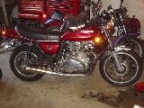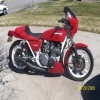low compression after rebuild
- wiredgeorge
-

- Offline
- User
-

Registered
- Posts: 5309
- Thanks: 45
Re: low compression after rebuild
17 Oct 2006 10:57
vegasjetskier - Just curious... you noted that "if you are testing a cold engine, the numbers will be too low". I have never noticed an a great difference (more than 10 PSI) between cold and warmed up compression testing. Usually a good deal less. Are you basing your comment on personal experience or quoting a manual? Just curious as noted.
I have never seen a shop manual describe compression testing on an engine that has not yet had the rings cut the hone in the cylinders. I doubt that compression will be all that great but I personally have never tested compression on a freshly rebuilt engine with absolutely no break-in such as Andrews. I WOULD expect that there would be enough compression to get the thing started... as a guess 100 PSI but if anyone has a number from actual testing, I would be curious. Obvious things to check without breaking the engine apart:
1. valve timing recheck (bent valves)
2. leak down to see if it is valves or rings (WD40 test indicated rings!)
3. verify compression test methodology
One of the hardest problems to solve is where someone seemingly did everything right. I know a little of Andrew and he is a real sharp guy and probably did a LOT of research before attempting the rebuild. Wish I were a little closer so I could drop by and lend a hand as he seems to have done most of the stuff right. I still think he should figure out where he lacks compression and ensure that his method for checking compression is right before breaking down the engine again as he MAY not discover where he is getting no compression.
I have never seen a shop manual describe compression testing on an engine that has not yet had the rings cut the hone in the cylinders. I doubt that compression will be all that great but I personally have never tested compression on a freshly rebuilt engine with absolutely no break-in such as Andrews. I WOULD expect that there would be enough compression to get the thing started... as a guess 100 PSI but if anyone has a number from actual testing, I would be curious. Obvious things to check without breaking the engine apart:
1. valve timing recheck (bent valves)
2. leak down to see if it is valves or rings (WD40 test indicated rings!)
3. verify compression test methodology
One of the hardest problems to solve is where someone seemingly did everything right. I know a little of Andrew and he is a real sharp guy and probably did a LOT of research before attempting the rebuild. Wish I were a little closer so I could drop by and lend a hand as he seems to have done most of the stuff right. I still think he should figure out where he lacks compression and ensure that his method for checking compression is right before breaking down the engine again as he MAY not discover where he is getting no compression.
wiredgeorge Motorcycle Carburetors
Mico TX
www.wgcarbs.com
Too many bikes to list!
Mico TX
www.wgcarbs.com
Too many bikes to list!
Please Log in or Create an account to join the conversation.
- nads.com
-
- Offline
- User
-

Registered
- Posts: 995
- Thanks: 20
Please Log in or Create an account to join the conversation.
- vegasjetskier
-
- Offline
- User
-

Registered
- Posts: 90
- Thanks: 1
Re: low compression after rebuild
17 Oct 2006 16:38
wiredgeorge wrote:
Experience with aircraft engines. Since the manual says to warm the engine up first, I'm assuming this applies to the KZs also. The only real way to know if the compression is correct is to follow the manufacturer's method for checking it. In this case, that means warming the engine first. What I'm saying with the above quote is that the numbers will be lower checking a cold engine, not necessarily that they will be below the minimum allowed spec.
Were the actual numbers ever posted? I didn't see them. Maybe compression's not the issue anyway.
vegasjetskier - Just curious... you noted that "if you are testing a cold engine, the numbers will be too low". I have never noticed an a great difference (more than 10 PSI) between cold and warmed up compression testing. Usually a good deal less. Are you basing your comment on personal experience or quoting a manual? Just curious as noted.
Experience with aircraft engines. Since the manual says to warm the engine up first, I'm assuming this applies to the KZs also. The only real way to know if the compression is correct is to follow the manufacturer's method for checking it. In this case, that means warming the engine first. What I'm saying with the above quote is that the numbers will be lower checking a cold engine, not necessarily that they will be below the minimum allowed spec.
Were the actual numbers ever posted? I didn't see them. Maybe compression's not the issue anyway.
Please Log in or Create an account to join the conversation.
- steell
-

- Offline
- User
-

Registered
- Posts: 6849
- Thanks: 208
Re: low compression after rebuild
17 Oct 2006 17:53
I checked several different KZ's both cold and hot one day, and the average difference in compression was 10 psi.
However I have never done a compression check on a freshly rebuilt motor, never had a need to.
However I have never done a compression check on a freshly rebuilt motor, never had a need to.
KD9JUR
Please Log in or Create an account to join the conversation.
- baldy110
-

- Offline
- User
-

Registered
- Posts: 2272
- Thanks: 512
Re: low compression after rebuild
18 Oct 2006 12:26
My last rebuild on my KZ650 I installed a big bore kit. After I got it all together my compression was really low below 80 on all cylinders. I got it started and broke it in. After about 500 miles my compression went to 170 PSI on all cylinders.
There is a big difference before and after the rings seat. If the bike will run I would run it hard for about 20 minutes then change the oil using 30 weight dino oil. Ride it a couple hundred miles and see. Just make sure you vary your speed.
There is a big difference before and after the rings seat. If the bike will run I would run it hard for about 20 minutes then change the oil using 30 weight dino oil. Ride it a couple hundred miles and see. Just make sure you vary your speed.
Please Log in or Create an account to join the conversation.
- vegasjetskier
-
- Offline
- User
-

Registered
- Posts: 90
- Thanks: 1
Re: low compression after rebuild
18 Oct 2006 12:47
Neotrion wrote:
You put them in dry? Who told you to do that? I have never heard of that. I've always used engine oil or assembly lube. The bore is the roughest it will ever be right after you hone it. If you put the cylinders on the pistons dry, it's quite possible that you scored or broke the piston rings, which would result in low compression and burning oil when you finally get it to run.
I'd put regular engine oil or some 20/50 in the bores. WD40 has a very thin oil in it.
I did some research on how to place the pistons back in the bores and decdied to put them in dry. Plus what would everyone suggest to put down those bores instead of wd40 that might help me a bit more?
You put them in dry? Who told you to do that? I have never heard of that. I've always used engine oil or assembly lube. The bore is the roughest it will ever be right after you hone it. If you put the cylinders on the pistons dry, it's quite possible that you scored or broke the piston rings, which would result in low compression and burning oil when you finally get it to run.
I'd put regular engine oil or some 20/50 in the bores. WD40 has a very thin oil in it.
Please Log in or Create an account to join the conversation.
- larrycavan
-
- User
-

Public
- Thanks: 0
Re: low compression after rebuild
18 Oct 2006 14:04
Dry assembly is becoming a common method for cylinders and pistons. Sometimes manufacturers even go as far as saying to wipe the block with acetone..
On a KZ motor, proper prep of a freshly honed block is as follows.
Wash the cylinders out with HOT SOAPY WATER and a bottle brush. Yes they will rust up immediately upon drying them
Next, use a soft, clean, white rag [T-Shirt]and put some oil into the cylinder. Rub the bores with oil, progressively wiping it until all tendancy of the rag to discolor [turb black] have ceased. Bear down on it when rubbing, rotate the cloth to new clean sections and gradually cut back on the oil.
Next, apply a very small amount of oil to the very bottom of the bore, reaching up in maybe 1 - 2 inches from the bottom...again...light coat.
Apply a few drops of oil to the piston skirts and spread it around on them.
Assemble the block onto the pistons, over the rings.
Turn the motor over several times while holding the cam chain. Then bring a pair of cylinders to BDC and again, with a clean white rag, wipe out any excess oil in the cylinder...bring the opposing cylinder pair to BDC and repeat the wiping. I generally do this twice to remove excess oil that is only going to burn and generate carbon.
I don't care if you've only got an initial 90 psi of compression on initial checking after re-ringing it. If you have it tuned properly, it will start and run.
This really is a straightforward situation with a straightforward solution.
1. Verify your cam timing is correct.
2. Verify you have valve clearance of anything between .002" - .006".
3. Verify your ignition timing is correct.
4. Verify your carburetion is in spec.
Start the motor and run it for several minutes.
a) If it runs, if it doesn't smoke, if it doesn't sputter, if there are no liquid leaks, take it for a ride and put some miles on it.
b) Bring it home, let it cool down enough to where you can pull the plugs and do a compression test without burning your hands. If, you have over 100 - 120 psi compression, no oil leaks, etc. Continue to put miles on the bike and check compression again after 100 miles.
Regarding rings: In general, if theres a dot near the end on one side, the dot side of the ring goes up.
If there's a bevel but no dot, the bevel goes up.
You mentioned nothing of, piston to cyl clearance, cylinder taper or ring end gap.
Post edited by: larrycavan, at: 2006/10/18 17:15
On a KZ motor, proper prep of a freshly honed block is as follows.
Wash the cylinders out with HOT SOAPY WATER and a bottle brush. Yes they will rust up immediately upon drying them
Next, use a soft, clean, white rag [T-Shirt]and put some oil into the cylinder. Rub the bores with oil, progressively wiping it until all tendancy of the rag to discolor [turb black] have ceased. Bear down on it when rubbing, rotate the cloth to new clean sections and gradually cut back on the oil.
Next, apply a very small amount of oil to the very bottom of the bore, reaching up in maybe 1 - 2 inches from the bottom...again...light coat.
Apply a few drops of oil to the piston skirts and spread it around on them.
Assemble the block onto the pistons, over the rings.
Turn the motor over several times while holding the cam chain. Then bring a pair of cylinders to BDC and again, with a clean white rag, wipe out any excess oil in the cylinder...bring the opposing cylinder pair to BDC and repeat the wiping. I generally do this twice to remove excess oil that is only going to burn and generate carbon.
I don't care if you've only got an initial 90 psi of compression on initial checking after re-ringing it. If you have it tuned properly, it will start and run.
This really is a straightforward situation with a straightforward solution.
1. Verify your cam timing is correct.
2. Verify you have valve clearance of anything between .002" - .006".
3. Verify your ignition timing is correct.
4. Verify your carburetion is in spec.
Start the motor and run it for several minutes.
a) If it runs, if it doesn't smoke, if it doesn't sputter, if there are no liquid leaks, take it for a ride and put some miles on it.
b) Bring it home, let it cool down enough to where you can pull the plugs and do a compression test without burning your hands. If, you have over 100 - 120 psi compression, no oil leaks, etc. Continue to put miles on the bike and check compression again after 100 miles.
Regarding rings: In general, if theres a dot near the end on one side, the dot side of the ring goes up.
If there's a bevel but no dot, the bevel goes up.
You mentioned nothing of, piston to cyl clearance, cylinder taper or ring end gap.
Post edited by: larrycavan, at: 2006/10/18 17:15
Please Log in or Create an account to join the conversation.
- Neotrion
-
Topic Author
- Offline
- User
-

Registered
- Posts: 45
- Thanks: 0
Re: low compression after rebuild
18 Oct 2006 14:31
hey WG did you get my message asking you about where you get your valve work done? My other bike is going to need some work.
Please Log in or Create an account to join the conversation.
- Neotrion
-
Topic Author
- Offline
- User
-

Registered
- Posts: 45
- Thanks: 0
Re: low compression after rebuild
18 Oct 2006 14:44
Thanks for your reply WG. I was just curious how much they charged. I like APE but it is a little step for me. I just wanted to see what the going rates were. It looks like on this set of heads they will need to be recut. Unlike on my other bike, when I lapped these valves in they didn't seem to seal at over 80 compression.
Please Log in or Create an account to join the conversation.
- nads.com
-
- Offline
- User
-

Registered
- Posts: 995
- Thanks: 20
Re: low compression after rebuild
18 Oct 2006 17:53
Man you guys rings take a long time to seat. Are you trying to make them last longer? Hee. I usually get a hair cut, cut my nails, put on a suit and tye, eat a good meal, not too salty, not too bland and then .......sleep on it since im nervous as heck ... a prayer... a deep breath.... sigh... ok.. lets roll. DAMN! only 20lbs! Wait a minute thats the gauge for the forks,
Please Log in or Create an account to join the conversation.
- wiredgeorge
-

- Offline
- User
-

Registered
- Posts: 5309
- Thanks: 45
Re: low compression after rebuild
18 Oct 2006 19:12
The reason I couldn't pin down my answer is that I wasn't sure what you needed done. If you dress the seats, I suspect it won't cost much at all... if you put in new guides, it will be more. I suspect a complete valve job to be in the $150 range...
If you lap the valves, check the seat with machinists dye... get some at an autoparts store and you can paint it on the seat then stick the valve in. Instead of a clean, lapped band, you will have a clean dye line which indicates a good seat. You just stick the valve in without spinning it. Any spots that are not even (which produces poor seal) will show in gaps in the dye. I think this works better than putting oil in the combustion chambers to see how long it seeps by the seat.
If you lap the valves, check the seat with machinists dye... get some at an autoparts store and you can paint it on the seat then stick the valve in. Instead of a clean, lapped band, you will have a clean dye line which indicates a good seat. You just stick the valve in without spinning it. Any spots that are not even (which produces poor seal) will show in gaps in the dye. I think this works better than putting oil in the combustion chambers to see how long it seeps by the seat.
wiredgeorge Motorcycle Carburetors
Mico TX
www.wgcarbs.com
Too many bikes to list!
Mico TX
www.wgcarbs.com
Too many bikes to list!
Please Log in or Create an account to join the conversation.
- Neotrion
-
Topic Author
- Offline
- User
-

Registered
- Posts: 45
- Thanks: 0
Re: low compression after rebuild
18 Oct 2006 20:28
WG would you know if the have email? It sounds to me like that is a reasonable price, the problem is just talking to them and get them there.
Please Log in or Create an account to join the conversation.
Moderators: Street Fighter LTD
